As we have seen in the previous section, the computation of the
configuration space ![]() is a very time-consuming task. The main idea
behind the Ariadne's clew algorithm is to avoid this computation. In
order to do this, the algorithm searches directly for a feasible path
in the trajectory space. The configuration space
is a very time-consuming task. The main idea
behind the Ariadne's clew algorithm is to avoid this computation. In
order to do this, the algorithm searches directly for a feasible path
in the trajectory space. The configuration space ![]() is never
explicitly computed.
is never
explicitly computed.
As will be shown, in the trajectory space, path planning may be seen as an optimization problem and solved as such by an algorithm called SEARCH. It is possible to build an approximation of free space by another algorithm called EXPLORE that is also posed as an optimization problem. The Ariadne's clew algorithm is the result of the interleaved execution of SEARCH and EXPLORE.
Given a robot with k DOF, a trajectory of length l may be
parameterized as a sequence of n=k*l successive movements. A
starting point ![]() along with such a parameterized trajectory
implicitly define a path and a final configuration
along with such a parameterized trajectory
implicitly define a path and a final configuration ![]() in the
configuration space. For example, for a holonomic mobile robot the
trajectory (
in the
configuration space. For example, for a holonomic mobile robot the
trajectory ( ![]() ) can be
interpreted as making a
) can be
interpreted as making a ![]() degree turn, moving straight
degree turn, moving straight ![]() ,
making a
,
making a ![]() degree turn and so on. Given the starting
configuration
degree turn and so on. Given the starting
configuration ![]() , this trajectory leads to the final configuration
, this trajectory leads to the final configuration
![]() (see Figure 3).
(see Figure 3).
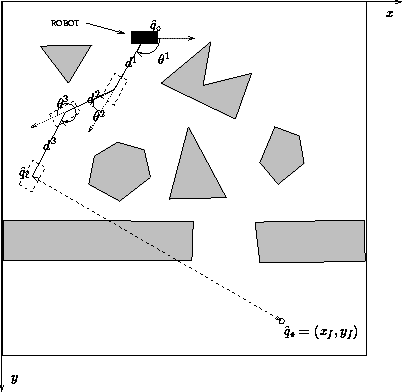
Figure 3: A parameterized trajectory
( ![]() ) and a starting point
) and a starting point
![]() implicitly define a path (in the operational space) for a
holonomic mobile robot.
implicitly define a path (in the operational space) for a
holonomic mobile robot.
Given a distance function d on the configuration space, if we find a
trajectory such that it does not collide with any obstacles and such
that the distance between ![]() and the goal
and the goal ![]() is zero, then we
have a solution to our path planning problem. Therefore, the path
planning problem may be seen as a minimization problem where:
is zero, then we
have a solution to our path planning problem. Therefore, the path
planning problem may be seen as a minimization problem where:

The algorithm SEARCH, based on this very simple technique and a randomized optimization method, is already able to solve quite complex problems of robot motion planning. For example, Figure 4 represents the two paths found for the holonomic mobile robot. Each path was computed on a standard workstation (SPARC 5) in less than 0.5 second without using any pre-computation of the configuration space. Thus, it is possible, albeit slowly, to get a planner that can be used in a dynamic environment (where the obstacles may move) by ``dropping'' a new world into the system every 0.5 second. SEARCH is very efficient but it is not complete, since it may fail to find a path even if one exists for two different reasons:
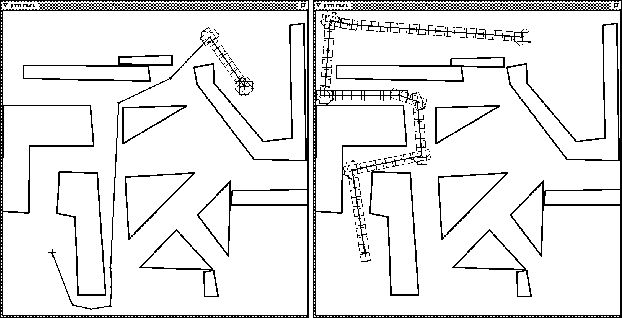
Figure 4: Reactive replanning in a changing environment
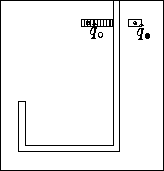
Figure 5: A problem leading to a local minimum. In such a case, a solution
path has first to move away from the goal. The goal's ``attraction''
based on the minimization of the Euclidean distance prevents SEARCH
from finding such a path.
In order to build a complete planner, we propose a second algorithm
called EXPLORE. While the purpose of SEARCH was to look directly for a
path from ![]() to
to ![]() , the purpose of EXPLORE is to compute an
approximation of the region of the configuration space accessible from
, the purpose of EXPLORE is to compute an
approximation of the region of the configuration space accessible from
![]() .
.
The EXPLORE algorithm builds an approximation of the accessible space
by placing landmarks in the configuration space ![]() in such a way
that a path from the initial position
in such a way
that a path from the initial position ![]() to any landmark is
known. In order to learn as much as possible about the free space, the
EXPLORE algorithm tries to spread the landmarks uniformly over the
space (see Figure 6). To do this, it tries to put the
landmarks as far as possible from one another by maximizing the
distances between them.
to any landmark is
known. In order to learn as much as possible about the free space, the
EXPLORE algorithm tries to spread the landmarks uniformly over the
space (see Figure 6). To do this, it tries to put the
landmarks as far as possible from one another by maximizing the
distances between them.
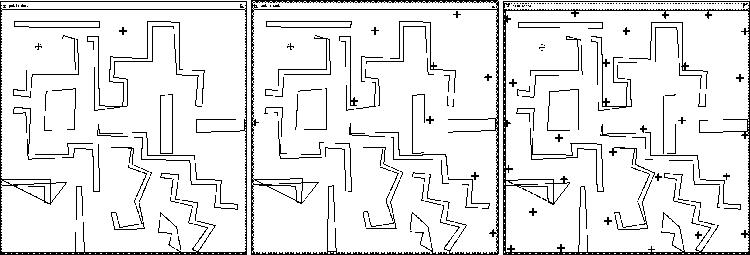
Figure 6: The first picture represents the initial position and the first
landmark. The subsequent landmarks are then uniformly spread over the
search space while the method keeps track of all paths joining the
landmarks to the initial position. The algorithm is named after
Ariadne because by placing landmarks, EXPLORE unwinds as if it were
using a thread as Theseus did.
Therefore, EXPLORE may be seen as a maximization problem where:
In order to have a planner that is both complete and efficient, we combined the two previous algorithms SEARCH and EXPLORE to obtain the Ariadne's clew algorithm.
The principle of the Ariadne's clew algorithm is very simple:
The Ariadne's clew algorithm will find a path if one exists. In an overwhelming number of cases, just a few landmarks are necessary for the Ariadne's clew algorithm to reach the target and stop.
A typical difficulty for a path planning algorithm is to find a collision-free path through a small corridor in the configuration space. This is also the case for the basic version of the Ariadne's clew algorithm, presented above. The problem is that very few trajectories encode such paths and therefore they are very difficult to find. Most trajectories collide with the obstacles. We propose a very simple idea to deal with this problem: going backwards at each collision point. If, for a given trajectory, a collision is detected along the corresponding path, then we simply consider transforming that trajectory so that it encodes a new path, one that is found by bouncing off the obstacle at the collision point (see Figure 7). Note that this construction is applied recursively until the entire trajectory corresponds to a collision-free path.
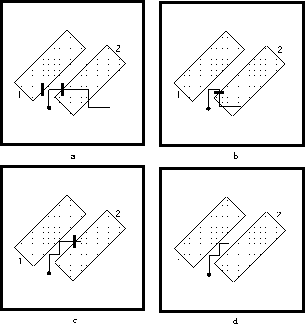
Figure 7: Bouncing against ![]() -obstacles. Figure (a) presents the original path
in the configuration space. Figure (b) shows the same path after two
bounces along the second segment on obstacle 2 and on obstacle
1. Figure (c) is the result obtained after a bounce of segment 3
against obstacle 2. Finally, Figure (d) presents a valid path obtained
after a final bounce of segment 4 against obstacle 2.
-obstacles. Figure (a) presents the original path
in the configuration space. Figure (b) shows the same path after two
bounces along the second segment on obstacle 2 and on obstacle
1. Figure (c) is the result obtained after a bounce of segment 3
against obstacle 2. Finally, Figure (d) presents a valid path obtained
after a final bounce of segment 4 against obstacle 2.
Using this technique, all trajectories are so transformed that they encode valid paths. This improved version of the Ariadne's clew algorithm no longer cares about obstacles. From the point of view of a search in the trajectory space, it is as if the obstacles have simply vanished. This method is especially efficient for narrow corridors in the configuration space. Without bouncing, the mapping of a corridor in the configuration space to the trajectory space is a set of very few points. With bouncing, every single trajectory going through a part of the corridor is ``folded'' into the corridor (see Figure 7). The resultant mapping of the corridor in the trajectory space is consequently a much larger set of points, and therefore it is much easier to find a member of this set. This empirical improvement has a major practical impact because it makes the proposed algorithm faster (fifteen times) in the problem considered below.
We can now give a final version of the Ariadne's clew algorithm. It
has three inputs: ![]() (the initial position),
(the initial position), ![]() (the goal
position), and
(the goal
position), and ![]() (the maximum allowed distance for a path to the
(the maximum allowed distance for a path to the
![]() ). It returns a legal path or terminates if no path exists at the
given resolution.
). It returns a legal path or terminates if no path exists at the
given resolution.
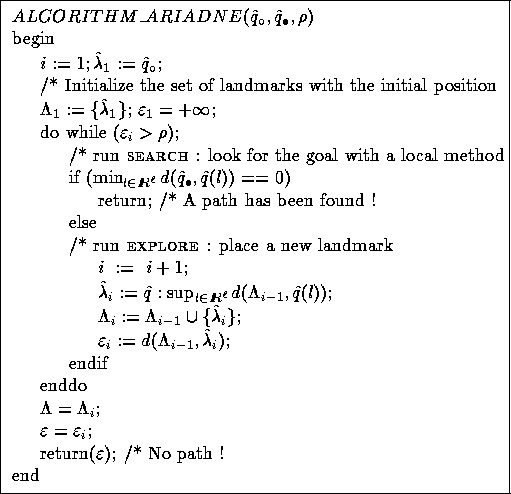
Figure 8: The Ariadne's Clew Algorithm
The algorithm is based on the following optimization problems:


![]() denotes the extremity of a legal path parameterized with
denotes the extremity of a legal path parameterized with
![]() real parameters and starting either from each of the previously
placed landmarks (EXPLORE) or from the latest placed landmark
(SEARCH).
real parameters and starting either from each of the previously
placed landmarks (EXPLORE) or from the latest placed landmark
(SEARCH).
The algorithm is resolution-complete under the following assumptions:
In practice, the first condition cannot be met with a randomized optimization algorithm in a bounded time, and only local maxima are found. However, the landmarks placed according to the new algorithm are better distributed over the free space than landmarks placed randomly, leading to better performances. The goal of the next section is to justify this claim, experimentally.